Unit 8 How do you make a banana milk shake?复习课件 (共47张PPT)
文档属性
| 名称 | Unit 8 How do you make a banana milk shake?复习课件 (共47张PPT) | 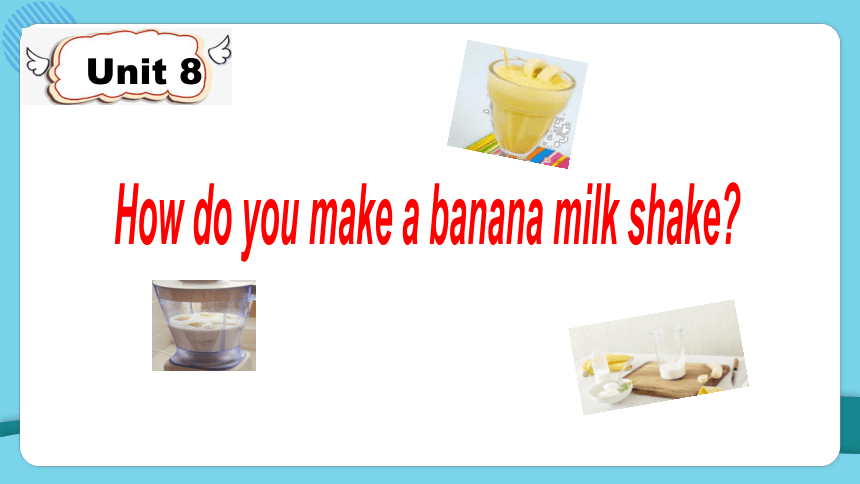 | |
| 格式 | pptx | ||
| 文件大小 | 3.9MB | ||
| 资源类型 | 教案 | ||
| 版本资源 | 人教新目标(Go for it)版 | ||
| 科目 | 英语 | ||
| 更新时间 | 2023-12-04 13:56:54 | ||
图片预览

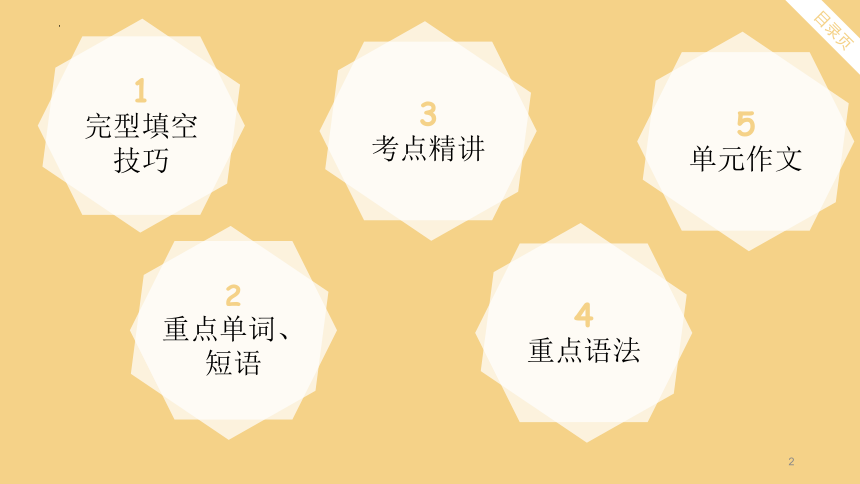

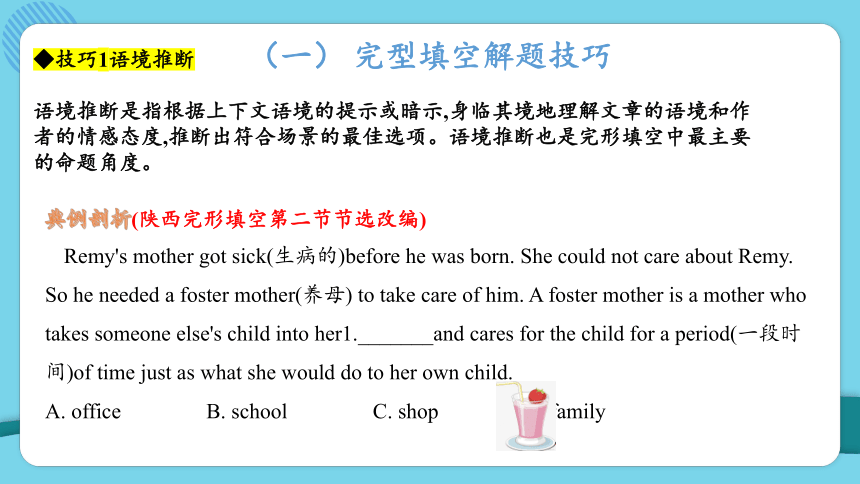
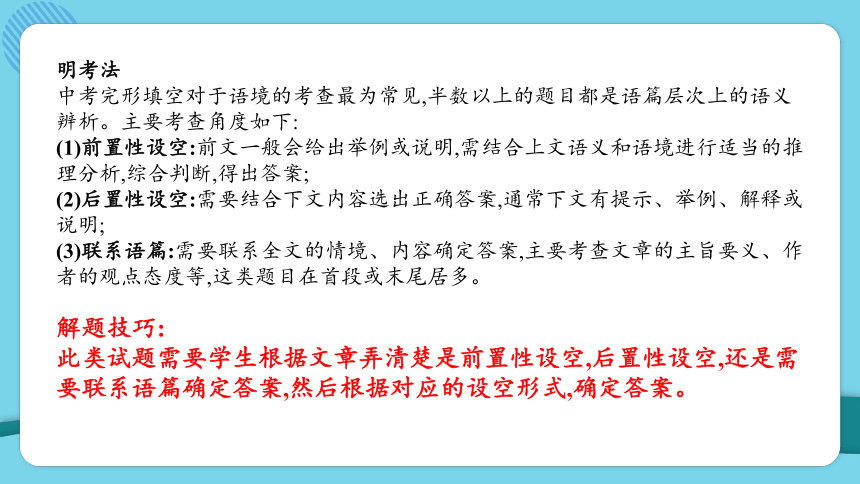
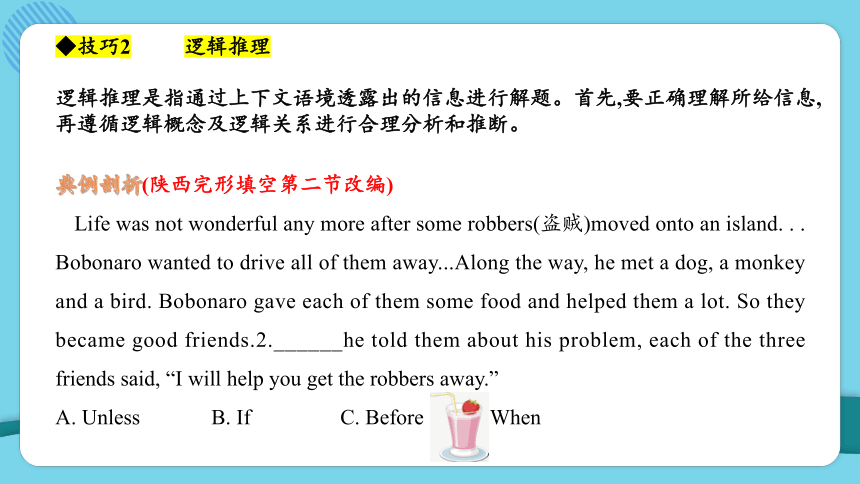
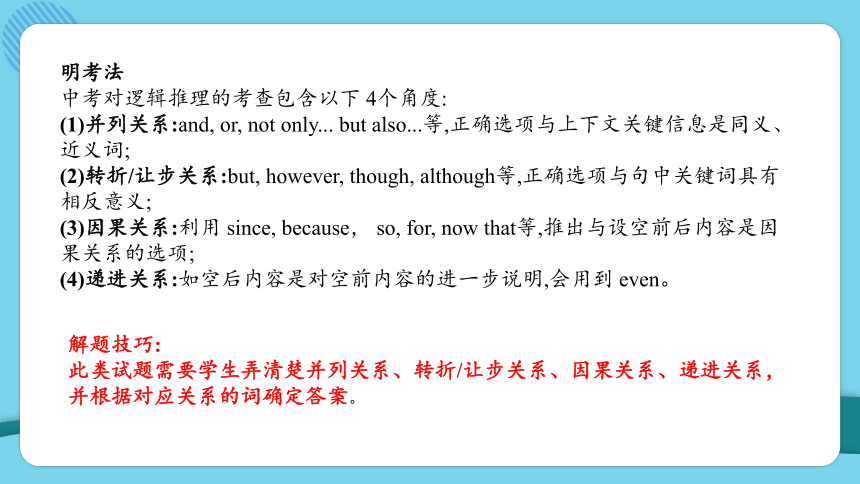
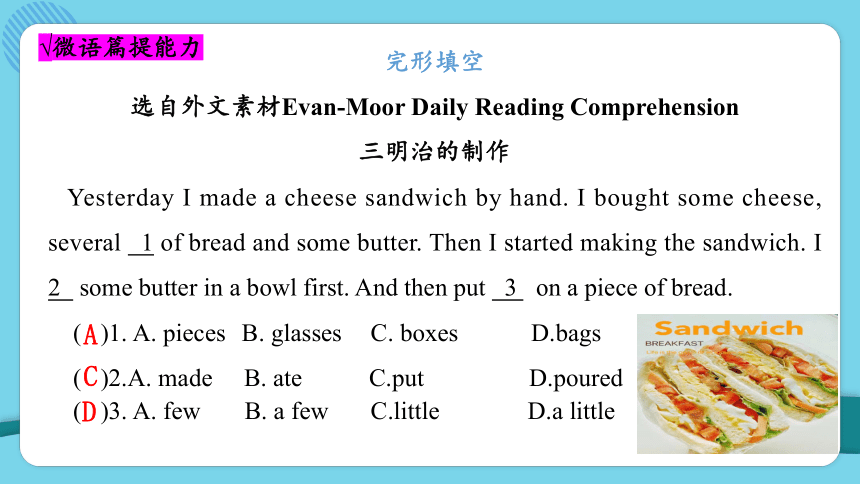
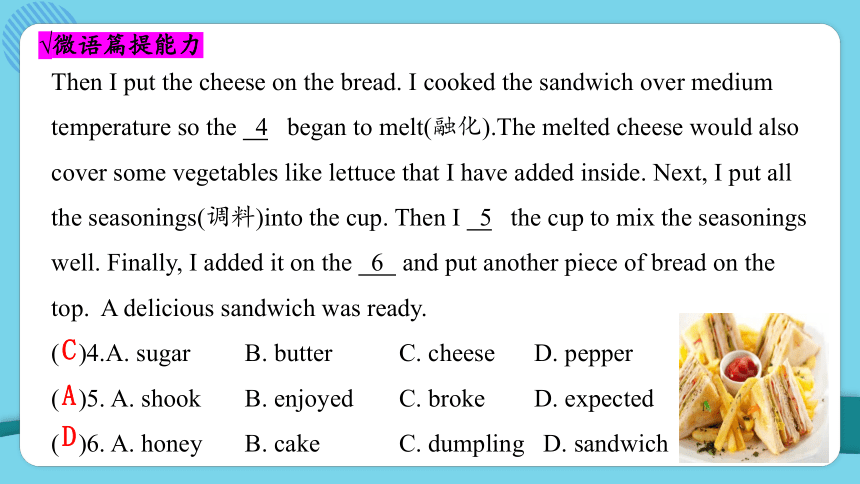

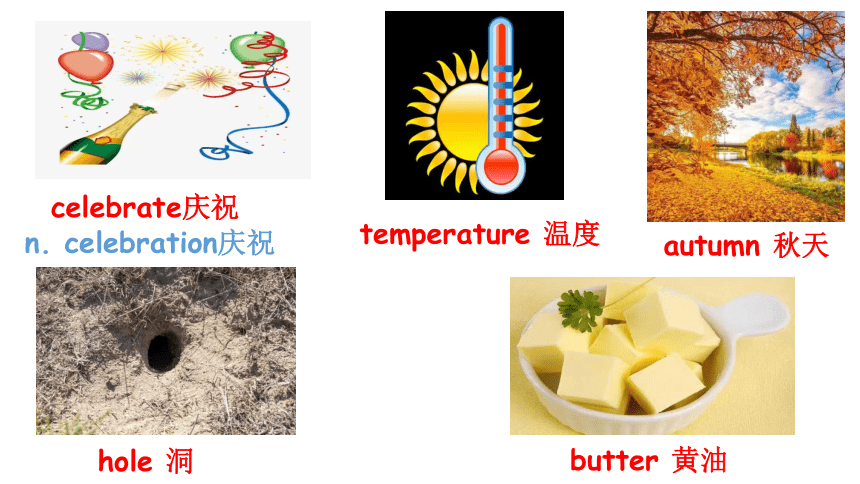
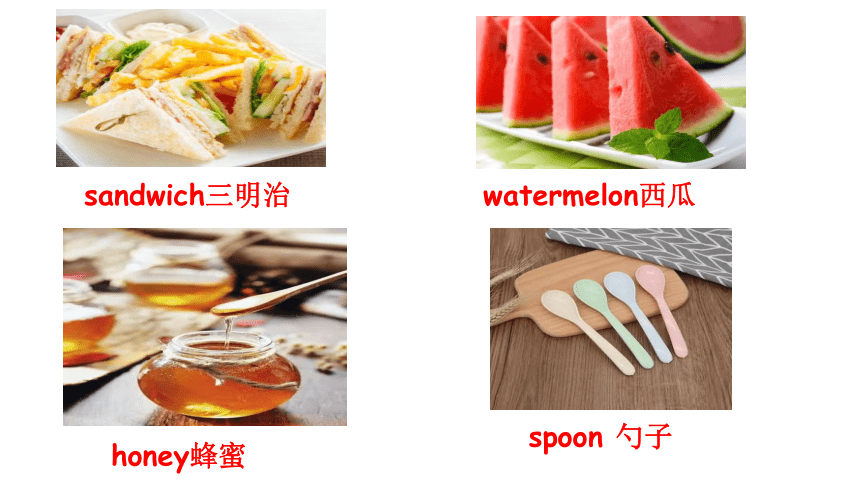
文档简介
(共47张PPT)
How do you make a banana milk shake
Unit 8
1完型填空技巧目录页2重点单词、短语3考点精讲5单元作文4重点语法完型填空技巧讲解
过渡页
1
◆技巧1语境推断
语境推断是指根据上下文语境的提示或暗示,身临其境地理解文章的语境和作者的情感态度,推断出符合场景的最佳选项。语境推断也是完形填空中最主要的命题角度。
典例剖析(陕西完形填空第二节节选改编)
Remy's mother got sick(生病的)before he was born. She could not care about Remy. So he needed a foster mother(养母) to take care of him. A foster mother is a mother who takes someone else's child into her1._______and cares for the child for a period(一段时间)of time just as what she would do to her own child.
A. office B. school C. shop D. family
(一) 完型填空解题技巧
明考法
中考完形填空对于语境的考查最为常见,半数以上的题目都是语篇层次上的语义辨析。主要考查角度如下:
(1)前置性设空:前文一般会给出举例或说明,需结合上文语义和语境进行适当的推理分析,综合判断,得出答案;
(2)后置性设空:需要结合下文内容选出正确答案,通常下文有提示、举例、解释或说明;
(3)联系语篇:需要联系全文的情境、内容确定答案,主要考查文章的主旨要义、作者的观点态度等,这类题目在首段或末尾居多。
解题技巧:
此类试题需要学生根据文章弄清楚是前置性设空,后置性设空,还是需要联系语篇确定答案,然后根据对应的设空形式,确定答案。
◆技巧2 逻辑推理
逻辑推理是指通过上下文语境透露出的信息进行解题。首先,要正确理解所给信息,再遵循逻辑概念及逻辑关系进行合理分析和推断。
典例剖析(陕西完形填空第二节改编)
Life was not wonderful any more after some robbers(盗贼)moved onto an island. . . Bobonaro wanted to drive all of them away...Along the way, he met a dog, a monkey and a bird. Bobonaro gave each of them some food and helped them a lot. So they became good friends.2.______he told them about his problem, each of the three friends said, “I will help you get the robbers away.”
A. Unless B. If C. Before D. When
明考法
中考对逻辑推理的考查包含以下 4个角度:
(1)并列关系:and, or, not only... but also...等,正确选项与上下文关键信息是同义、近义词;
(2)转折/让步关系:but, however, though, although等,正确选项与句中关键词具有相反意义;
(3)因果关系:利用 since, because, so, for, now that等,推出与设空前后内容是因果关系的选项;
(4)递进关系:如空后内容是对空前内容的进一步说明,会用到 even。
解题技巧:
此类试题需要学生弄清楚并列关系、转折/让步关系、因果关系、递进关系,并根据对应关系的词确定答案。
完形填空
选自外文素材Evan-Moor Daily Reading Comprehension
三明治的制作
Yesterday I made a cheese sandwich by hand. I bought some cheese, several 1 of bread and some butter. Then I started making the sandwich. I 2 some butter in a bowl first. And then put 3 on a piece of bread.
( )1. A. pieces B. glasses C. boxes D.bags
( )2.A. made B. ate C.put D.poured
( )3. A. few B. a few C.little D.a little
√微语篇提能力
A
C
D
Then I put the cheese on the bread. I cooked the sandwich over medium temperature so the 4 began to melt(融化).The melted cheese would also cover some vegetables like lettuce that I have added inside. Next, I put all the seasonings(调料)into the cup. Then I 5 the cup to mix the seasonings well. Finally, I added it on the 6 and put another piece of bread on the top. A delicious sandwich was ready.
( )4.A. sugar B. butter C. cheese D. pepper
( )5. A. shook B. enjoyed C. broke D. expected
( )6. A. honey B. cake C. dumpling D. sandwich
√微语篇提能力
C
A
D
重点单词、短语
过渡页
2
celebrate庆祝
n. celebration庆祝
temperature 温度
autumn 秋天
hole 洞
butter 黄油
sandwich三明治
watermelon西瓜
honey蜂蜜
spoon 勺子
shake摇动;摇晃
milk shake奶昔
salt盐
cover n.封面
v.覆盖;遮盖
prepare准备
(二) 重点单词、短语回顾
一、根据句意及汉语提示填写单词
(教材 P58 改编)Don't forget to add some_________(盐) to Russian soup.
Mary put some sugar into the coffee and _________ (摇动) the cup quickly.
Linda, please help me put a_________ (勺)of milk into the tea.
The _________ (蜂蜜) from my hometown is really delicious.
My favorite fruit is__________________ (西瓜)and I often eat a lot in summer.
salt
shake
spoon
honey
watermelon
(二) 重点单词、短语回顾
6. (教材 P60改编)Put the tomatoes on the_________ (三明治).
7.(教材 P103 改编) After everything is ready, put another_________ (片)of bread on top.
8. My brother doesn't like any_________ (黄油)in a hamburger at all, but I like that a lot.
9. Linda likes lettuce, and she usually_________ (添加)some to her noodles.
10. Please put the tree in the_________ (洞)and pour some water into it.
sandwich
piece
butter
add
hole
(二) 重点单词、短语回顾
11.(教材 P61改编)In most countries, people usually eat_________ (传统的)food on special days.
12.(教材 P61改编) The Spring Festival is a time for people to get together and they usually_________ (庆祝)it with a big family meal.
13.It's very important to control the______________ (温度)when we cook the food.
14. My parents usually spend several days helping my grandma pick apples in_________ (秋天) each year.
15. Listening to music is one of my________(hobby), and it makes me relax a lot.
traditional
celebrate
temperature
autumn
hobbies
奶昔__________________
接通(电流、煤气、水等);打开__________________
切碎_____________
把…倒进…里__________________
把…放进…里__________________
一杯酸奶_____________
做(罗宋)汤/爆米花/牛肉面__________________
另外10分钟__________________
从…中拿出…__________________
一片/块/段__________________
重点短语
milk shake
turn on
cut up
pour into
put into
a/one cup of yogurt
make (Russian) soup/popcorn/beef noodles
another ten minutes
take out from…=take…out of
a piece of
反义词:turn off关闭
强调倾倒液体
既可以放液体,也可以放固体。
重点短语
11. 对…表示感谢__________________
12. 把…和…混合__________________
13. 用…装满…__________________
14. 一些;几个__________________
15. 用…覆盖__________________
16. 把…切成…__________________
17. 用某物招待某人__________________
18. 以高温;在高温下___________
19. 现在;如今__________________
20. 一个接一个__________________
give thanks for
mix…and…
fill…with…
a few+名词复数
cover…with…
cut…into…
serve sth to sb=serve sb(with) sth.
at a very high temperature
these days
one by one
be filled with…充满了
=be full of
be covered with被覆盖。
翻译句子
1.你怎样做香蕉奶昔?
__________________________________________________________2. 我们需要多少香蕉?
__________________________________________________________
3. 我们需要多少酸奶?
__________________________________________________________4. 这是为感恩节大餐制作火鸡的一种方法。
__________________________________________________________5. 现在就是享有米线的时刻了!
__________________________________________________________
How do you make a banana milk shake
How many bananas do we need
How much yogurt do we need
Here is one way to make turkey for a Thanksgiving dinner.
Now, it’s time to enjoy the rice noodles!
固定句型:It’s time (for sb) to do sth(某人)是时候该做某事了。
考点精讲
过渡页
3
(三)考点精讲
how many“多少”,问数量 后接可数名词复数形式
how much“多少”问数量或问价格 后接不可数名词
要点1 how many 和how much
-How many books are there on the desk 桌上有几本书?
-There are five. 有五本。
-How much is your schoolbag 你的书包多少钱?
-It’s 100 yuan. 一百元。
-How much milk is there in the bottle 瓶子里有多少牛奶?
-There is only a little. 只有一点儿。
【典例分析】
( )1.—________apples are there in the basket
—Six.
A. How old B. How much C. How many D. How
( )2. — _________is the bike?
— Only 150 yuan.
A. How much B. How many C. How long D. How often
( )3. — _______ juice do we need
—Four bottles.
A. How much B. How many C. How old D. How heavy
( )4. —______ is the price of the two pairs of shoes
—_______ _______ 100 yuan.
What, It is B. How much, It’s
C. What, They are D. How much, They are
( )5. I want to make a banana shake. Please tell me, ______ milk do I need, and ______ bananas do I need
A. how much; how much B. how many; how many
C. how much; how many D. how many; how much
要点2 turn on
(1)在英语中,由“动词 + 副词”构成的短语动词的宾语如果是代词,只能放在动词与副词之间;如果是名词,既可以放在它们之间,也可以放在副词之后。turn与off; on; up; down; over搭配均是动副结构。例如:
Please turn the tap off. Don’t turn it on. 请把水龙头关掉,别打开。
Turn on the computer. = Turn the computer on. 打开电脑。
(2)turn on与open的辨析:
①turn on通常指打开水龙头、煤气或电灯、电视等电器的开关,其对应词为turn off。
②open指把关着或封着的门、窗、箱子、盒子等打开,其对应词为close。例如:
I want to watch the football match. Please turn on the TV. 我想看足球比赛,请把电视打开。
Please open the door for me. 请为我开门。
(3)与turn相关的短语:
turn up (把音量)调大,调高 turn down (把音量)调小,调低
turn in 上交 turn into使成为;翻译成 turn off关;熄灭(灯、煤气等)
【典例分析】
1.He (打开) the computer and begins to do his home work.
Please __________________(打开) the door and let the boy come in.
( )2. ---- Sara, __________ the TV right now. It’s time to go to bed.
---- Oh, Mum, this is my favourite programme!
A. turn on B. turn off C. turn up D. turn down
turns on
turn on
( )3. How noisy it is! Could you please ____ the CD player a little
A. turn off B. turn down C. turn on D. turn up
( )4. Mum wants to watch the CCTV news. Let’s __________ the TV.
A. turn down B. turn off C. turn to D. turn on
( )5. I want to use the computer. Can you
A. turn on it B. turn it on C. turn it off D. turn off it
要点3 cut up
cut up意为“切碎”,其同义词组为cut into pieces。cut up后跟代词作宾语时,代词应放在cut和up之间;接名词作宾语时,名词通常放在up后。
例如:
cut it(them) up 把它(它们)切碎 cut up the apple 把那个苹果切碎
【拓展】
cut down砍倒;砍伐;减少 cut off切断;切除 cut out 删除 cut in插嘴
【典例分析】
( )1.Elephants are losing their homes because people________ too many trees.
A. cut up B. cut out C. cut off D. cut down
( )2. We must cut ______ the tomatoes and put them _______ the blender.
A.off; in B.up; in C.down; into D.over; in
要点4 add 的用法
add作动词,意为“加,增加”,常用以下结构:
(1)add… to… 意为“把……加到……”,例如:
Don’t add fuel to the flames. 别再火上浇油了。
(2)add to表示“增加;增添”,其中to是介词,后接名词或代词。例如:
Each girl present at the party was wearing a flower in the hair, which added to their beauty.
参加晚会的姑娘人人头上都戴有一朵花,使得她们显得愈加漂亮。
(3)add up to 意为“总计;加起来结果是”。例如:
All the numbers add up to exactly 900. 所有数加起来一共900.
【典例分析】
( )1. If more salt______ to the soup, it will taste better.
A. is added B. will be added C. will add D. Adds
( )2.Please ________ all the figures to see how much they ________.
A. add; add up B. add up; add up to C. add up; add up D. add; add to
( )3. He_________ some sugar _________ the coffee.
A. put;at B. added;to C. added;with D. added;/
要点5 prepare 的用法
prepare 意为“使做好准备;把……准备好”。用法如下:
①prepare for=get ready for为……做准备
②prepare to do sth.准备做某事
③prepare sth. for sb.为某人准备某物
【拓展】
prepare的名词形式为preparation,意为“准备”时,作不可数名词;意为“准备工作”时,作可数名词。
( )1. Look!The Whites are _______ for a big family dinner in the kitchen.
A. looking B. asking C. preparing D. caring
( )2. ________ everything ahead of time, and you will be successful.
A. look B. ask C. prepare D. care
要点6 cover的用法
(1)cover动词,意为“遮盖;覆盖;包含,包括”。常见用法如下:
①cover...with...用……覆盖……
②sth. be covered with...某物被……覆盖
如:Linda covered her face with her hands.琳达用手遮住脸。
The table is covered with a cloth.桌子被一块布盖着。
(2)cover名词,意为“覆盖物,盖子;(书刊等的)封面,封皮”。
如:This glass bowl has a plastic cover.这个玻璃碗有一个塑料盖子。
( )1. When we arrived home, the inside of our house was _______ with rain water.
A. helped B. covered C. mixed D. made
( )2. During May, most places in China are warm. But Mount Qomolangma is still cold and covered_________ snow.
A. with B. to C. by D. for
重点语法
过渡页
4
(四)重点语法
(一)可数名词和不可数名词的用法区别
(1)可数名词有单数和复数两种形式,而不可数名词没有复数形式。
(2)不定冠词a/an、 基数词可直接修饰可数名词,表示数量。而不可数名词在表示数量时, 则用“冠词/基数词+表示计量单位的名词+of+不可数名词”。
(3)可数名词复数前可用many, some, any, few, a few, a lot of, lots of等修饰;不可数名词 前可用much, some, any, little, a little, a lot of, lots of等修饰。
(4)可数名词作主语时,谓语动词与主语的单复数保持一致,不可数名词作主语时,谓语动词用第三人称单数形式
(5) 提问可数名词的数量用how many,提问不可数名词的数量用how much。
后面只接可数名词复数:many, few, a few
后面只接不可数名词:much, little, a little
后面既可以接可数名词复数也可接不可数名词:some, any, a lot of, lots of
1 名词复数的规则变化:
(1) 一般情况下在词尾加-s。如:book → books, chair → chairs
(2)以s, x, sh, ch结尾的名词,在词尾加-es。如:
class → classes, box → boxes
(3) 以f或fe结尾的名词,先将f或fe变为v,再加-es。如:
shelf → shelves, wife → wives
以f或fe结尾的单词口诀:
1 名词复数的规则变化:
(4) 以o结尾的名词,词尾加-es或-s。如:
tomato → tomatoes, photo → photos
(5) 以辅音字母加y结尾的名词,先将y改为i,再加-es。
如:
baby → babies, factory → factories
2 名词复数的不规则变化:
(1) 元音字母发生变化。如:
man → men, woman → women, foot → feet,
tooth → teeth, mouse → mice, goose → geese
(2) 单、复数形式相同。如:deer, fish, sheep, Chinese, Japanese
(3) 词尾发生变化。如:child → children
(4) 有些名词只有复数形式。如:clothes, trousers, people
(5) man, woman修饰其他名词时,单复数要与被修饰的名词保持一致。如:a man doctor → men doctors
单复数同形口诀:中国人和日本人骑着羊和鹿去吃鱼。
【典例分析】
一、将可数名词和不可数名词分类,填入对应的位置:
apple, bread, coffee, egg, juice, milk, potato, advice, tomato, tea, desk, guitar, tree, bus, weather, information
可数名词:____________________________________________________________________
不可数名词:____________________________________________________________________
【答案】可数名词:apple, egg, potato, tomato, tea, desk, guitar, tree, bus,
不可数名词bread, coffee, juice, milk, advice, tea, weather, information
二、用单词的适当形式填空
1. How many________________ do you have (dictionary)
2. She likes eating noodles very much and she doesn’t add too much salt to them. (tomato)
3. There is a by the river and there are many on the hill. (sheep)
4. Linda bought two in the supermarket last night. (knife)
5. These watches were made by . (German)
dictionaries
tomato
sheep
sheep
knives
Germans
6. is my favorite color and I also like eating best. (orange)
7. No matter what time we are getting through, (hero) are always around us.
8. My aunt's baby has four (tooth) now.
9. Let life be beautiful like summer flowers and death like autumn (leaf).
10. I have some (photo) that I took in Australia last year.
Orange
orange
heroes
teeth
leaves
photos
(二)祈使句
祈使句表示命令、请求、建议或劝告等。主语通常被省略,谓语动词用原形,句末用感叹号或句号。
一、祈使句的肯定句式:一般分为以下四种类型:
(1)实义动词+其他成分。
Make sentences after the model. 根据例句造句。
(2)Be动词+其他成分(形容词、名词或介词短语等)。
Be careful when crossing the street. 过马路时要小心。
(3)Let+宾语+动词原形+其他成分。
Let him go back now. 让他现在回去吧。
(4)无动词祈使句。
This way,please!请这边走!
Just a minute,please!请稍等片刻!
二、祈使句的否定句式
祈使句的否定句式,通常情况下在动词原形前加上don't或never,一般分为以下三种类型:
(1)在肯定祈使句的动词原形前加don't,构成“Don't+动词原形+其他成分”。
Don't say that again!别再那样说了!
(2)let引导的祈使句的否定形式有两种:
① 以let开头的祈使句,如果后面跟第一、第三人称名词或代词的宾格,在let前加don't。
Don't let me go with her tomorrow. 不要让我明天跟她一起去。
② 以let's开头的祈使句,必须在let's后加not。
Let's not play computer games from now on.从现在开始,我们不玩电脑游戏了吧。
(3)在公共场合的提示语中,否定祈使句常用
“No+名词/动词的 ing形式”结构,表示“禁止做某事”。
NO PHOTOS!禁止拍照!
【典例分析】
( )1.Tom, ________ afraid of speaking out your ideas.
A. don't B. not C. not be D. don't be
( )2.Don't run in the hallways and________ arrive late for class.
A. not to B. won't C. don't D. no
( )3. ________ kind and helpful to the people around us, and we will make the world a nice place to live in.
A.Be B.Being C.To be D.Been
【典例分析】
( )4. “_____exercise every day,my son. It’s good for your health,”Dad often says to him.
A. Takes B.Taking C.Take D.To take
( )5. _____wake up your sister,Ben. She needs a good sleep.
A.Don’t B. Doesn’t C. Aren’t D.Can’t
( )6._____carefully,please! There is a school ahead.
A.Drive B.Driving C.To drive D.Drove
( )7. --_____the dishes after dinner,Tony.
--No problem,Mom.
A.Washing B.Washes C.To wash D.Wash
( )8.--Tom,_____here to carry the luggage upstairs for me,will you
--All right.
A.come B.came C.coming D.to come
( )9. _______ on doing sports every day, and you’ll have a healthy body.
A. Keep B. To keep C. Keeps D. Keeping
( )10.______ walk on the grass.
A. Doesn’t B. Don’t C. Not
How do you make a banana milk shake
Unit 8
1完型填空技巧目录页2重点单词、短语3考点精讲5单元作文4重点语法完型填空技巧讲解
过渡页
1
◆技巧1语境推断
语境推断是指根据上下文语境的提示或暗示,身临其境地理解文章的语境和作者的情感态度,推断出符合场景的最佳选项。语境推断也是完形填空中最主要的命题角度。
典例剖析(陕西完形填空第二节节选改编)
Remy's mother got sick(生病的)before he was born. She could not care about Remy. So he needed a foster mother(养母) to take care of him. A foster mother is a mother who takes someone else's child into her1._______and cares for the child for a period(一段时间)of time just as what she would do to her own child.
A. office B. school C. shop D. family
(一) 完型填空解题技巧
明考法
中考完形填空对于语境的考查最为常见,半数以上的题目都是语篇层次上的语义辨析。主要考查角度如下:
(1)前置性设空:前文一般会给出举例或说明,需结合上文语义和语境进行适当的推理分析,综合判断,得出答案;
(2)后置性设空:需要结合下文内容选出正确答案,通常下文有提示、举例、解释或说明;
(3)联系语篇:需要联系全文的情境、内容确定答案,主要考查文章的主旨要义、作者的观点态度等,这类题目在首段或末尾居多。
解题技巧:
此类试题需要学生根据文章弄清楚是前置性设空,后置性设空,还是需要联系语篇确定答案,然后根据对应的设空形式,确定答案。
◆技巧2 逻辑推理
逻辑推理是指通过上下文语境透露出的信息进行解题。首先,要正确理解所给信息,再遵循逻辑概念及逻辑关系进行合理分析和推断。
典例剖析(陕西完形填空第二节改编)
Life was not wonderful any more after some robbers(盗贼)moved onto an island. . . Bobonaro wanted to drive all of them away...Along the way, he met a dog, a monkey and a bird. Bobonaro gave each of them some food and helped them a lot. So they became good friends.2.______he told them about his problem, each of the three friends said, “I will help you get the robbers away.”
A. Unless B. If C. Before D. When
明考法
中考对逻辑推理的考查包含以下 4个角度:
(1)并列关系:and, or, not only... but also...等,正确选项与上下文关键信息是同义、近义词;
(2)转折/让步关系:but, however, though, although等,正确选项与句中关键词具有相反意义;
(3)因果关系:利用 since, because, so, for, now that等,推出与设空前后内容是因果关系的选项;
(4)递进关系:如空后内容是对空前内容的进一步说明,会用到 even。
解题技巧:
此类试题需要学生弄清楚并列关系、转折/让步关系、因果关系、递进关系,并根据对应关系的词确定答案。
完形填空
选自外文素材Evan-Moor Daily Reading Comprehension
三明治的制作
Yesterday I made a cheese sandwich by hand. I bought some cheese, several 1 of bread and some butter. Then I started making the sandwich. I 2 some butter in a bowl first. And then put 3 on a piece of bread.
( )1. A. pieces B. glasses C. boxes D.bags
( )2.A. made B. ate C.put D.poured
( )3. A. few B. a few C.little D.a little
√微语篇提能力
A
C
D
Then I put the cheese on the bread. I cooked the sandwich over medium temperature so the 4 began to melt(融化).The melted cheese would also cover some vegetables like lettuce that I have added inside. Next, I put all the seasonings(调料)into the cup. Then I 5 the cup to mix the seasonings well. Finally, I added it on the 6 and put another piece of bread on the top. A delicious sandwich was ready.
( )4.A. sugar B. butter C. cheese D. pepper
( )5. A. shook B. enjoyed C. broke D. expected
( )6. A. honey B. cake C. dumpling D. sandwich
√微语篇提能力
C
A
D
重点单词、短语
过渡页
2
celebrate庆祝
n. celebration庆祝
temperature 温度
autumn 秋天
hole 洞
butter 黄油
sandwich三明治
watermelon西瓜
honey蜂蜜
spoon 勺子
shake摇动;摇晃
milk shake奶昔
salt盐
cover n.封面
v.覆盖;遮盖
prepare准备
(二) 重点单词、短语回顾
一、根据句意及汉语提示填写单词
(教材 P58 改编)Don't forget to add some_________(盐) to Russian soup.
Mary put some sugar into the coffee and _________ (摇动) the cup quickly.
Linda, please help me put a_________ (勺)of milk into the tea.
The _________ (蜂蜜) from my hometown is really delicious.
My favorite fruit is__________________ (西瓜)and I often eat a lot in summer.
salt
shake
spoon
honey
watermelon
(二) 重点单词、短语回顾
6. (教材 P60改编)Put the tomatoes on the_________ (三明治).
7.(教材 P103 改编) After everything is ready, put another_________ (片)of bread on top.
8. My brother doesn't like any_________ (黄油)in a hamburger at all, but I like that a lot.
9. Linda likes lettuce, and she usually_________ (添加)some to her noodles.
10. Please put the tree in the_________ (洞)and pour some water into it.
sandwich
piece
butter
add
hole
(二) 重点单词、短语回顾
11.(教材 P61改编)In most countries, people usually eat_________ (传统的)food on special days.
12.(教材 P61改编) The Spring Festival is a time for people to get together and they usually_________ (庆祝)it with a big family meal.
13.It's very important to control the______________ (温度)when we cook the food.
14. My parents usually spend several days helping my grandma pick apples in_________ (秋天) each year.
15. Listening to music is one of my________(hobby), and it makes me relax a lot.
traditional
celebrate
temperature
autumn
hobbies
奶昔__________________
接通(电流、煤气、水等);打开__________________
切碎_____________
把…倒进…里__________________
把…放进…里__________________
一杯酸奶_____________
做(罗宋)汤/爆米花/牛肉面__________________
另外10分钟__________________
从…中拿出…__________________
一片/块/段__________________
重点短语
milk shake
turn on
cut up
pour into
put into
a/one cup of yogurt
make (Russian) soup/popcorn/beef noodles
another ten minutes
take out from…=take…out of
a piece of
反义词:turn off关闭
强调倾倒液体
既可以放液体,也可以放固体。
重点短语
11. 对…表示感谢__________________
12. 把…和…混合__________________
13. 用…装满…__________________
14. 一些;几个__________________
15. 用…覆盖__________________
16. 把…切成…__________________
17. 用某物招待某人__________________
18. 以高温;在高温下___________
19. 现在;如今__________________
20. 一个接一个__________________
give thanks for
mix…and…
fill…with…
a few+名词复数
cover…with…
cut…into…
serve sth to sb=serve sb(with) sth.
at a very high temperature
these days
one by one
be filled with…充满了
=be full of
be covered with被覆盖。
翻译句子
1.你怎样做香蕉奶昔?
__________________________________________________________2. 我们需要多少香蕉?
__________________________________________________________
3. 我们需要多少酸奶?
__________________________________________________________4. 这是为感恩节大餐制作火鸡的一种方法。
__________________________________________________________5. 现在就是享有米线的时刻了!
__________________________________________________________
How do you make a banana milk shake
How many bananas do we need
How much yogurt do we need
Here is one way to make turkey for a Thanksgiving dinner.
Now, it’s time to enjoy the rice noodles!
固定句型:It’s time (for sb) to do sth(某人)是时候该做某事了。
考点精讲
过渡页
3
(三)考点精讲
how many“多少”,问数量 后接可数名词复数形式
how much“多少”问数量或问价格 后接不可数名词
要点1 how many 和how much
-How many books are there on the desk 桌上有几本书?
-There are five. 有五本。
-How much is your schoolbag 你的书包多少钱?
-It’s 100 yuan. 一百元。
-How much milk is there in the bottle 瓶子里有多少牛奶?
-There is only a little. 只有一点儿。
【典例分析】
( )1.—________apples are there in the basket
—Six.
A. How old B. How much C. How many D. How
( )2. — _________is the bike?
— Only 150 yuan.
A. How much B. How many C. How long D. How often
( )3. — _______ juice do we need
—Four bottles.
A. How much B. How many C. How old D. How heavy
( )4. —______ is the price of the two pairs of shoes
—_______ _______ 100 yuan.
What, It is B. How much, It’s
C. What, They are D. How much, They are
( )5. I want to make a banana shake. Please tell me, ______ milk do I need, and ______ bananas do I need
A. how much; how much B. how many; how many
C. how much; how many D. how many; how much
要点2 turn on
(1)在英语中,由“动词 + 副词”构成的短语动词的宾语如果是代词,只能放在动词与副词之间;如果是名词,既可以放在它们之间,也可以放在副词之后。turn与off; on; up; down; over搭配均是动副结构。例如:
Please turn the tap off. Don’t turn it on. 请把水龙头关掉,别打开。
Turn on the computer. = Turn the computer on. 打开电脑。
(2)turn on与open的辨析:
①turn on通常指打开水龙头、煤气或电灯、电视等电器的开关,其对应词为turn off。
②open指把关着或封着的门、窗、箱子、盒子等打开,其对应词为close。例如:
I want to watch the football match. Please turn on the TV. 我想看足球比赛,请把电视打开。
Please open the door for me. 请为我开门。
(3)与turn相关的短语:
turn up (把音量)调大,调高 turn down (把音量)调小,调低
turn in 上交 turn into使成为;翻译成 turn off关;熄灭(灯、煤气等)
【典例分析】
1.He (打开) the computer and begins to do his home work.
Please __________________(打开) the door and let the boy come in.
( )2. ---- Sara, __________ the TV right now. It’s time to go to bed.
---- Oh, Mum, this is my favourite programme!
A. turn on B. turn off C. turn up D. turn down
turns on
turn on
( )3. How noisy it is! Could you please ____ the CD player a little
A. turn off B. turn down C. turn on D. turn up
( )4. Mum wants to watch the CCTV news. Let’s __________ the TV.
A. turn down B. turn off C. turn to D. turn on
( )5. I want to use the computer. Can you
A. turn on it B. turn it on C. turn it off D. turn off it
要点3 cut up
cut up意为“切碎”,其同义词组为cut into pieces。cut up后跟代词作宾语时,代词应放在cut和up之间;接名词作宾语时,名词通常放在up后。
例如:
cut it(them) up 把它(它们)切碎 cut up the apple 把那个苹果切碎
【拓展】
cut down砍倒;砍伐;减少 cut off切断;切除 cut out 删除 cut in插嘴
【典例分析】
( )1.Elephants are losing their homes because people________ too many trees.
A. cut up B. cut out C. cut off D. cut down
( )2. We must cut ______ the tomatoes and put them _______ the blender.
A.off; in B.up; in C.down; into D.over; in
要点4 add 的用法
add作动词,意为“加,增加”,常用以下结构:
(1)add… to… 意为“把……加到……”,例如:
Don’t add fuel to the flames. 别再火上浇油了。
(2)add to表示“增加;增添”,其中to是介词,后接名词或代词。例如:
Each girl present at the party was wearing a flower in the hair, which added to their beauty.
参加晚会的姑娘人人头上都戴有一朵花,使得她们显得愈加漂亮。
(3)add up to 意为“总计;加起来结果是”。例如:
All the numbers add up to exactly 900. 所有数加起来一共900.
【典例分析】
( )1. If more salt______ to the soup, it will taste better.
A. is added B. will be added C. will add D. Adds
( )2.Please ________ all the figures to see how much they ________.
A. add; add up B. add up; add up to C. add up; add up D. add; add to
( )3. He_________ some sugar _________ the coffee.
A. put;at B. added;to C. added;with D. added;/
要点5 prepare 的用法
prepare 意为“使做好准备;把……准备好”。用法如下:
①prepare for=get ready for为……做准备
②prepare to do sth.准备做某事
③prepare sth. for sb.为某人准备某物
【拓展】
prepare的名词形式为preparation,意为“准备”时,作不可数名词;意为“准备工作”时,作可数名词。
( )1. Look!The Whites are _______ for a big family dinner in the kitchen.
A. looking B. asking C. preparing D. caring
( )2. ________ everything ahead of time, and you will be successful.
A. look B. ask C. prepare D. care
要点6 cover的用法
(1)cover动词,意为“遮盖;覆盖;包含,包括”。常见用法如下:
①cover...with...用……覆盖……
②sth. be covered with...某物被……覆盖
如:Linda covered her face with her hands.琳达用手遮住脸。
The table is covered with a cloth.桌子被一块布盖着。
(2)cover名词,意为“覆盖物,盖子;(书刊等的)封面,封皮”。
如:This glass bowl has a plastic cover.这个玻璃碗有一个塑料盖子。
( )1. When we arrived home, the inside of our house was _______ with rain water.
A. helped B. covered C. mixed D. made
( )2. During May, most places in China are warm. But Mount Qomolangma is still cold and covered_________ snow.
A. with B. to C. by D. for
重点语法
过渡页
4
(四)重点语法
(一)可数名词和不可数名词的用法区别
(1)可数名词有单数和复数两种形式,而不可数名词没有复数形式。
(2)不定冠词a/an、 基数词可直接修饰可数名词,表示数量。而不可数名词在表示数量时, 则用“冠词/基数词+表示计量单位的名词+of+不可数名词”。
(3)可数名词复数前可用many, some, any, few, a few, a lot of, lots of等修饰;不可数名词 前可用much, some, any, little, a little, a lot of, lots of等修饰。
(4)可数名词作主语时,谓语动词与主语的单复数保持一致,不可数名词作主语时,谓语动词用第三人称单数形式
(5) 提问可数名词的数量用how many,提问不可数名词的数量用how much。
后面只接可数名词复数:many, few, a few
后面只接不可数名词:much, little, a little
后面既可以接可数名词复数也可接不可数名词:some, any, a lot of, lots of
1 名词复数的规则变化:
(1) 一般情况下在词尾加-s。如:book → books, chair → chairs
(2)以s, x, sh, ch结尾的名词,在词尾加-es。如:
class → classes, box → boxes
(3) 以f或fe结尾的名词,先将f或fe变为v,再加-es。如:
shelf → shelves, wife → wives
以f或fe结尾的单词口诀:
1 名词复数的规则变化:
(4) 以o结尾的名词,词尾加-es或-s。如:
tomato → tomatoes, photo → photos
(5) 以辅音字母加y结尾的名词,先将y改为i,再加-es。
如:
baby → babies, factory → factories
2 名词复数的不规则变化:
(1) 元音字母发生变化。如:
man → men, woman → women, foot → feet,
tooth → teeth, mouse → mice, goose → geese
(2) 单、复数形式相同。如:deer, fish, sheep, Chinese, Japanese
(3) 词尾发生变化。如:child → children
(4) 有些名词只有复数形式。如:clothes, trousers, people
(5) man, woman修饰其他名词时,单复数要与被修饰的名词保持一致。如:a man doctor → men doctors
单复数同形口诀:中国人和日本人骑着羊和鹿去吃鱼。
【典例分析】
一、将可数名词和不可数名词分类,填入对应的位置:
apple, bread, coffee, egg, juice, milk, potato, advice, tomato, tea, desk, guitar, tree, bus, weather, information
可数名词:____________________________________________________________________
不可数名词:____________________________________________________________________
【答案】可数名词:apple, egg, potato, tomato, tea, desk, guitar, tree, bus,
不可数名词bread, coffee, juice, milk, advice, tea, weather, information
二、用单词的适当形式填空
1. How many________________ do you have (dictionary)
2. She likes eating noodles very much and she doesn’t add too much salt to them. (tomato)
3. There is a by the river and there are many on the hill. (sheep)
4. Linda bought two in the supermarket last night. (knife)
5. These watches were made by . (German)
dictionaries
tomato
sheep
sheep
knives
Germans
6. is my favorite color and I also like eating best. (orange)
7. No matter what time we are getting through, (hero) are always around us.
8. My aunt's baby has four (tooth) now.
9. Let life be beautiful like summer flowers and death like autumn (leaf).
10. I have some (photo) that I took in Australia last year.
Orange
orange
heroes
teeth
leaves
photos
(二)祈使句
祈使句表示命令、请求、建议或劝告等。主语通常被省略,谓语动词用原形,句末用感叹号或句号。
一、祈使句的肯定句式:一般分为以下四种类型:
(1)实义动词+其他成分。
Make sentences after the model. 根据例句造句。
(2)Be动词+其他成分(形容词、名词或介词短语等)。
Be careful when crossing the street. 过马路时要小心。
(3)Let+宾语+动词原形+其他成分。
Let him go back now. 让他现在回去吧。
(4)无动词祈使句。
This way,please!请这边走!
Just a minute,please!请稍等片刻!
二、祈使句的否定句式
祈使句的否定句式,通常情况下在动词原形前加上don't或never,一般分为以下三种类型:
(1)在肯定祈使句的动词原形前加don't,构成“Don't+动词原形+其他成分”。
Don't say that again!别再那样说了!
(2)let引导的祈使句的否定形式有两种:
① 以let开头的祈使句,如果后面跟第一、第三人称名词或代词的宾格,在let前加don't。
Don't let me go with her tomorrow. 不要让我明天跟她一起去。
② 以let's开头的祈使句,必须在let's后加not。
Let's not play computer games from now on.从现在开始,我们不玩电脑游戏了吧。
(3)在公共场合的提示语中,否定祈使句常用
“No+名词/动词的 ing形式”结构,表示“禁止做某事”。
NO PHOTOS!禁止拍照!
【典例分析】
( )1.Tom, ________ afraid of speaking out your ideas.
A. don't B. not C. not be D. don't be
( )2.Don't run in the hallways and________ arrive late for class.
A. not to B. won't C. don't D. no
( )3. ________ kind and helpful to the people around us, and we will make the world a nice place to live in.
A.Be B.Being C.To be D.Been
【典例分析】
( )4. “_____exercise every day,my son. It’s good for your health,”Dad often says to him.
A. Takes B.Taking C.Take D.To take
( )5. _____wake up your sister,Ben. She needs a good sleep.
A.Don’t B. Doesn’t C. Aren’t D.Can’t
( )6._____carefully,please! There is a school ahead.
A.Drive B.Driving C.To drive D.Drove
( )7. --_____the dishes after dinner,Tony.
--No problem,Mom.
A.Washing B.Washes C.To wash D.Wash
( )8.--Tom,_____here to carry the luggage upstairs for me,will you
--All right.
A.come B.came C.coming D.to come
( )9. _______ on doing sports every day, and you’ll have a healthy body.
A. Keep B. To keep C. Keeps D. Keeping
( )10.______ walk on the grass.
A. Doesn’t B. Don’t C. Not
同课章节目录
- Unit 1 Where did you go on vacation?
- Section A
- Section B
- Unit 2 How often do you exercise?
- Section A
- Section B
- Unit 3 I'm more outgoing than my sister.
- Section A
- Section B
- Unit 4 What's the best movie theater?
- Section A
- Section B
- Unit 5 Do you want to watch a game show?
- Section A
- Section B
- Unit 6 I'm going to study computer science.
- Section A
- Section B
- Unit 7 Will people have robots?
- Section A
- Section B
- Unit 8 How do you make a banana milk shake?
- Section A
- Section B
- Unit 9 Can you come to my party?
- Section A
- Section B
- Unit 10 If you go to the party, you'll have a grea
- Section A
- Section B
